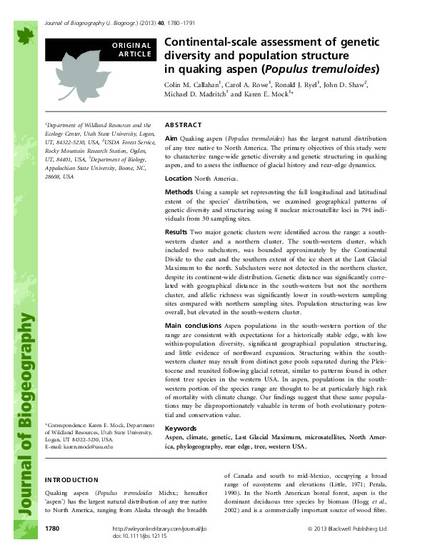
Article
Continental-scale assessment of genetic diversity and population structure in quaking aspen (Populus tremuloides)
Journal of Biogeography
(2013)
Abstract
Aim Quaking aspen (Populus tremuloides) has the largest natural distribution of any tree native to North America. The primary objectives of this study were to characterize range-wide genetic diversity and genetic structuring in quaking aspen, and to assess the influence of glacial history and rear-edge dynamics....Main conclusions Aspen populations in the south-western portion of the range are consistent with expectations for a historically stable edge, with low within-population diversity, significant geographical population structuring, and little evidence of northward expansion. Structuring within the southwestern cluster may result from distinct gene pools separated during the Pleistocene and reunited following glacial retreat, similar to patterns found in other forest tree species in the western USA. In aspen, populations in the southwestern portion of the species range are thought to be at particularly high risk of mortality with climate change. Our findings suggest that these same populations may be disproportionately valuable in terms of both evolutionary potential and conservation value.
Keywords
- Author Keywords:Aspen; climate; genetic; Last Glacial Maximum; microsatellites; North America; phylogeography; rear edge; tree; western USA
Disciplines
Publication Date
September, 2013
DOI
https://doi.org/10.1111/jbi.12115
Publisher Statement
USDA Forest Service Publication
Citation Information
Karen E. Mock. "Continental-scale assessment of genetic diversity and population structure in quaking aspen (Populus tremuloides)" Journal of Biogeography Vol. 40 Iss. 9 (2013) p. 1780 - 1791 Available at: http://works.bepress.com/karen_mock/64/
